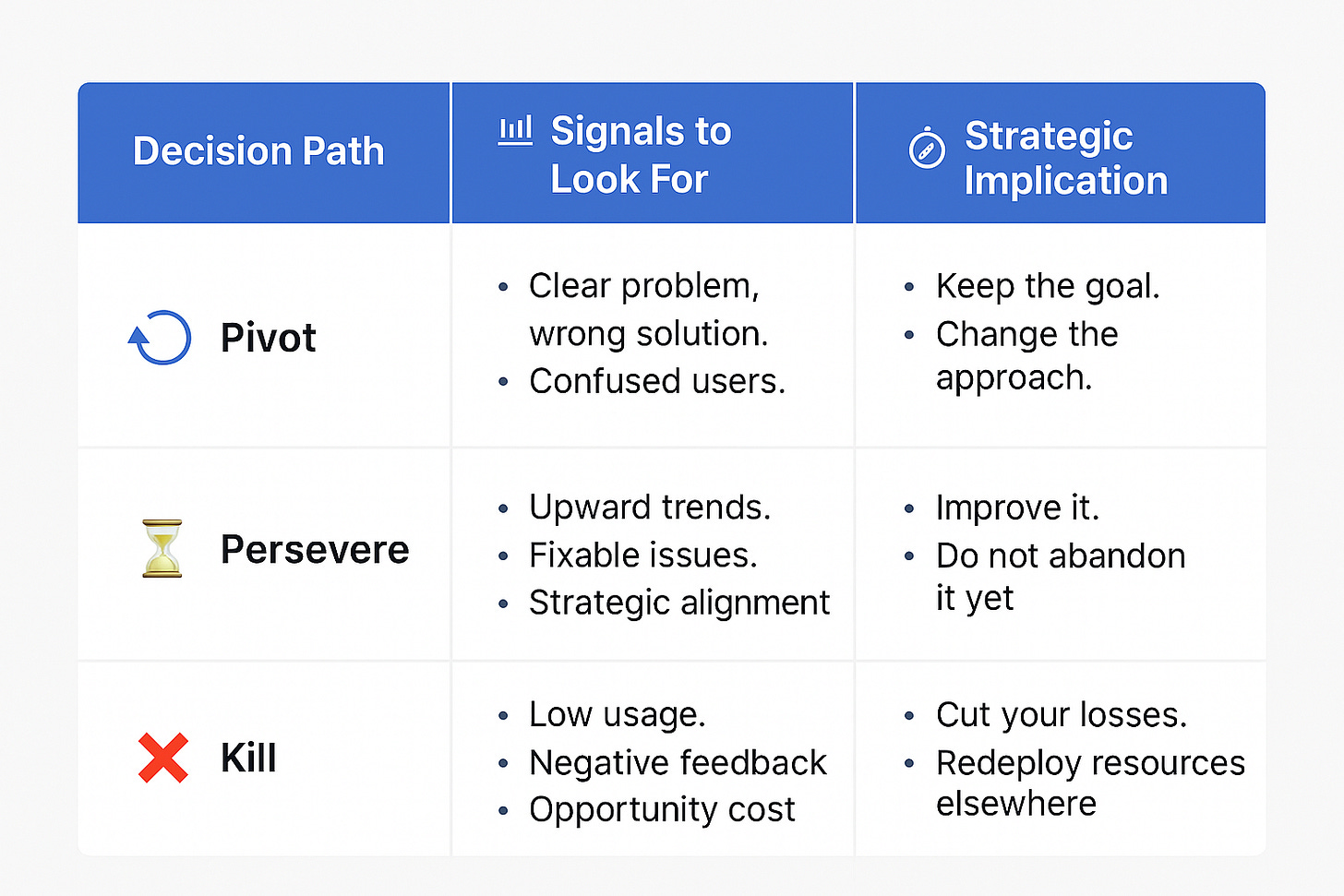Post-Launch Clarity: When to Pivot, Persevere, or Kill a Feature
What Great PMs Do After Launch: The Frameworks Behind Hard Post-Release Decisions
🎧 Now a Podcast Conversation
This article sparked a candid episode of The Product Leader’s Playbook, where two AI hosts unpack the real tension behind post-launch decision-making. From sunk cost bias to strategic misalignment, we break down what makes these moments so difficult - and how smart teams navigate them with clarity.
→ Listen on Spotify | Listen on Apple Podcasts
🚨 The Feature We Couldn’t Let Go
A few years back, we launched what we thought was a game-changing feature. The data was solid, the customer demand was validated, and our engineers delivered flawlessly. We even got internal kudos from leadership.
But a few weeks in, the signs started showing: flat adoption, mixed feedback, and no meaningful lift to our target metric.
Still, we hesitated.
Maybe we hadn’t messaged it right.
Maybe users just needed more time.
Maybe with one more sprint...
We kept tweaking. Kept hoping.
Eventually, we realized: the real mistake wasn’t launching it. It was keeping it alive too long.
🧠 The Hidden Cost of Indecision
As product leaders, one of the hardest calls isn’t what to build next, it’s what to do when something you’ve already shipped isn’t delivering.
Should you pivot? Persevere? Or shut it down?
Most teams treat launch as the finish line. But in reality, it’s the starting line for your highest-leverage decisions. Because:
Every “let’s give it one more sprint” has a cost.
Every “let’s wait for more data” delays the next opportunity.
Every “maybe it just needs better onboarding” drains focus.
Key insight: Not making a decision is a decision, and often the riskiest one of all.
🛣️ The 3 Strategic Paths
When a shipped feature isn’t meeting expectations, you generally have three options:
Pivot
You still believe in the underlying problem, but your current solution isn’t landing.
Users articulate a real need but are confused by what you’ve built.
You’ve invalidated old assumptions but uncovered new insights.
There's energy around the pain point, just not your execution.
Persevere
You’re seeing promising signals, even if the numbers aren’t great… yet.
Metrics are trending upward (even slowly).
Friction points are identifiable and solvable.
The feature supports critical user journeys or long-term strategy.
Kill
It’s not working. And worse, it’s blocking better bets.
Low usage + indifferent or negative feedback.
High maintenance cost with unclear ROI.
Strategic misalignment or opportunity cost too high to ignore.
Sometimes the most strategic move isn’t to push harder. It’s to let go.
Use this matrix as a quick-reference guide when evaluating post-launch features.
🧰 Frameworks to Clarify the Call
These are the 3 tools I rely on when things get murky:
1. Re-score with RICE (Post-Launch)
We score features before we build them. Why not after we launch them?
Ask:
Has the Impact shown up?
Is Confidence still high?
Does Effort to continue justify the return?
💡Tip: A drop in Reach or Confidence post-launch should trigger a reassessment.
2. The 3-Question Retrospective
Use this with your cross-functional team. It’s fast, honest, and cuts through the noise:
What assumptions did we get right?
What outcomes did we actually drive?
If we could do it again, would we build it the same way?
The goal isn’t blame. It’s clarity.
3. Opportunity Cost Mapping
Create a visual map of what else you could be doing if you freed up these resources.
Ask:
What initiatives are stalled because we’re maintaining this?
Would reallocating these people/time/energy drive higher value?
If the answer is yes, your decision just got easier.
🧭 How to Communicate a Hard Call
Killing a feature isn’t just a product call, it’s a leadership moment. Here’s how to navigate it:
Lead with data. Let the numbers tell the story.
Reframe the opportunity. Don’t just explain what’s ending - show what’s now possible.
Honor the work. Celebrate effort without clinging to sunk costs.
“Killing a feature isn’t failure. It’s focus.”
— Something every stakeholder needs to hear (and believe).
🧼 Strategic Clarity Beats Reluctant Momentum
Ruthless prioritization doesn’t just belong in your QBR deck, it belongs after the launch, when the stakes are real, and trade-offs are tangible.
Whether you pivot, persevere, or kill, your job is the same:
Protect your team’s focus
Maximize customer value
Move resources toward impact
Because the cost of indecision isn’t just technical debt, it’s organizational drag.
🔄 Your Turn
Have you ever held on to a feature too long? What finally tipped the scale?
What signals or frameworks does your team use to evaluate post-launch features?
Let’s open the playbook - drop a comment or share this with a team that’s facing a tough post-launch call. I’d love to hear your story.
🎧 Want to Go Deeper?
This article is also available as a podcast episode on:
🎙 The Product Leader’s Playbook – streaming everywhere:
🔹 YouTube | Amazon Music



